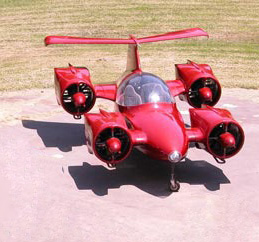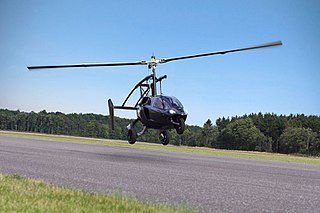
An aircraft is a vehicle that is able to fly by gaining support from the air. It counters the force of gravity by using either static lift or the dynamic lift of an airfoil, or, in a few cases, direct downward thrust from its engines. Common examples of aircraft include airplanes, helicopters, airships, gliders, paramotors, and hot air balloons.

A flying car or roadable aircraft is a type of vehicle which can function both as a road vehicle and as an aircraft. As used here, this includes vehicles which drive as motorcycles when on the road. The term "flying car" is also sometimes used to include hovercars and/or VTOL personal air vehicles. Many prototypes have been built since the early 20th century, using a variety of flight technologies. Most have been designed to take off and land conventionally using a runway. Although VTOL projects are increasing, none has yet been built in more than a handful of numbers.

A vertical take-off and landing (VTOL) aircraft is one that can take off and land vertically without relying on a runway. This classification can include a variety of types of aircraft including helicopters as well as thrust-vectoring fixed-wing aircraft and other hybrid aircraft with powered rotors such as cyclogyros/cyclocopters and gyrodynes.

The Moller Skycar is a flying car with VTOL capability which has been under development by Paul Moller for over fifty years. As of 2023, the M400 has not achieved free flight.

AeroVironment, Inc. is an American defense contractor headquartered in Arlington, Virginia, that designs and manufactures unmanned aerial vehicles (UAVs). Paul B. MacCready Jr., a designer of human-powered aircraft, founded the company in 1971. The company is best known for its lightweight human-powered and solar-powered vehicles. The company is the US military's top supplier of small drones —notably the Raven, Switchblade, Wasp and Puma models.

On a helicopter, the main rotor or rotor system is the combination of several rotary wings with a control system, that generates the aerodynamic lift force that supports the weight of the helicopter, and the thrust that counteracts aerodynamic drag in forward flight. Each main rotor is mounted on a vertical mast over the top of the helicopter, as opposed to a helicopter tail rotor, which connects through a combination of drive shaft(s) and gearboxes along the tail boom. The blade pitch is typically controlled by the pilot using the helicopter flight controls. Helicopters are one example of rotary-wing aircraft (rotorcraft). The name is derived from the Greek words helix, helik-, meaning spiral; and pteron meaning wing.

Terrafugia is a Chinese-owned corporation, based in Woburn, Massachusetts, United States that is developing a roadable aircraft called the Transition and a flying car called the TF-X. The Transition and TF-X are designed to be able to fold their wings, enabling the vehicles to also operate as street-legal road vehicles.

A personal air vehicle (PAV) is a proposed class of passenger aircraft providing on-demand air transport.

The M200G Neuera is a prototype of a flying saucer-style hovercraft, designed by aeronautics engineer Paul Moller. The vehicle is envisioned as a precursor to the Moller M400 Skycar. The M200G Volantor uses a system of eight computer-controlled fans to hover up to 10 feet (3 m) above the ground. Volantor is a term coined by Moller meaning "a vertical takeoff and landing aircraft."

In aviation, V-speeds are standard terms used to define airspeeds important or useful to the operation of all aircraft. These speeds are derived from data obtained by aircraft designers and manufacturers during flight testing for aircraft type-certification. Using them is considered a best practice to maximize aviation safety, aircraft performance, or both.

The Terrafugia Transition is a light sport, roadable airplane under development by Terrafugia since 2006.
Urban Air Mobility (UAM) is the use of small, highly automated aircraft to carry passengers or cargo at lower altitudes in urban and suburban areas which have been developed in response to traffic congestion. It usually refers to existing and emerging technologies such as traditional helicopters, vertical-takeoff-and-landing aircraft (VTOL), electrically propelled vertical-takeoff-and-landing aircraft (eVTOL), and unmanned aerial vehicles (UAVs). These aircraft are characterized by the use of multiple electric-powered rotors or fans for lift and propulsion, along with fly-by-wire systems to control them. Inventors have explored urban air mobility concepts since the early days of powered flight. However, advances in materials, computerized flight controls, batteries and electric motors improved innovation and designs beginning in the late 2010s. Most UAM proponents envision that the aircraft will be owned and operated by professional operators, as with taxis, rather than by private individuals.

The Lilium Jet is a prototype German electric vertical take-off and landing (eVTOL) electrically powered airplane designed by Lilium GmbH. A seven-seat production version is planned.

Joby Aviation is a United States venture-backed aviation company, developing an electric vertical takeoff and landing (eVTOL) aircraft that it intends to operate as an air taxi service. Joby Aviation is headquartered in Santa Cruz, California, and has offices in San Carlos, California; Marina, California; and Munich, Germany.

Beta Technologies, is a South Burlington, Vermont-based aerospace manufacturer developing electric vertical take off and landing (eVTOL) and electric conventional take-off and landing (eCTOL) aircraft for the cargo, medical passenger, and military aviation industries. The company has also developed a network of chargers which can supply power to their aircraft and other electric vehicles. Training programs for future electric aircraft pilots and maintainers are also provided.

The PAL-V Liberty is a combination of a three-wheeled car and an autogyro, or gyroplane under development by PAL-V of the Netherlands. Both a driver's license and an autogyro pilot's license are required to operate the vehicle.
An electric vertical take-off and landing (eVTOL) aircraft is a variety of VTOL aircraft that uses electric power to hover, take off, and land vertically. This technology came about thanks to major advances in electric propulsion and the emerging need for new aerial vehicles for urban air mobility that can enable greener and quieter flights. Electric and hybrid propulsion systems (EHPS) have also the potential of lowering the operating costs of aircraft.

Archer Aviation is a publicly traded company headquartered in San Jose, California, which is developing eVTOL aircraft.
Wisk Aero is an aerospace manufacturer based in Mountain View, California, United States. The company develops self-flying electric vertical take off and landing (eVTOL) aircraft designed to be operated as air taxis. The company was formed in 2019 as a partnership between Boeing and Google co-founder Larry Page's Kitty Hawk aircraft company.

Advanced Air Mobility (AAM) is an air transport system.


















